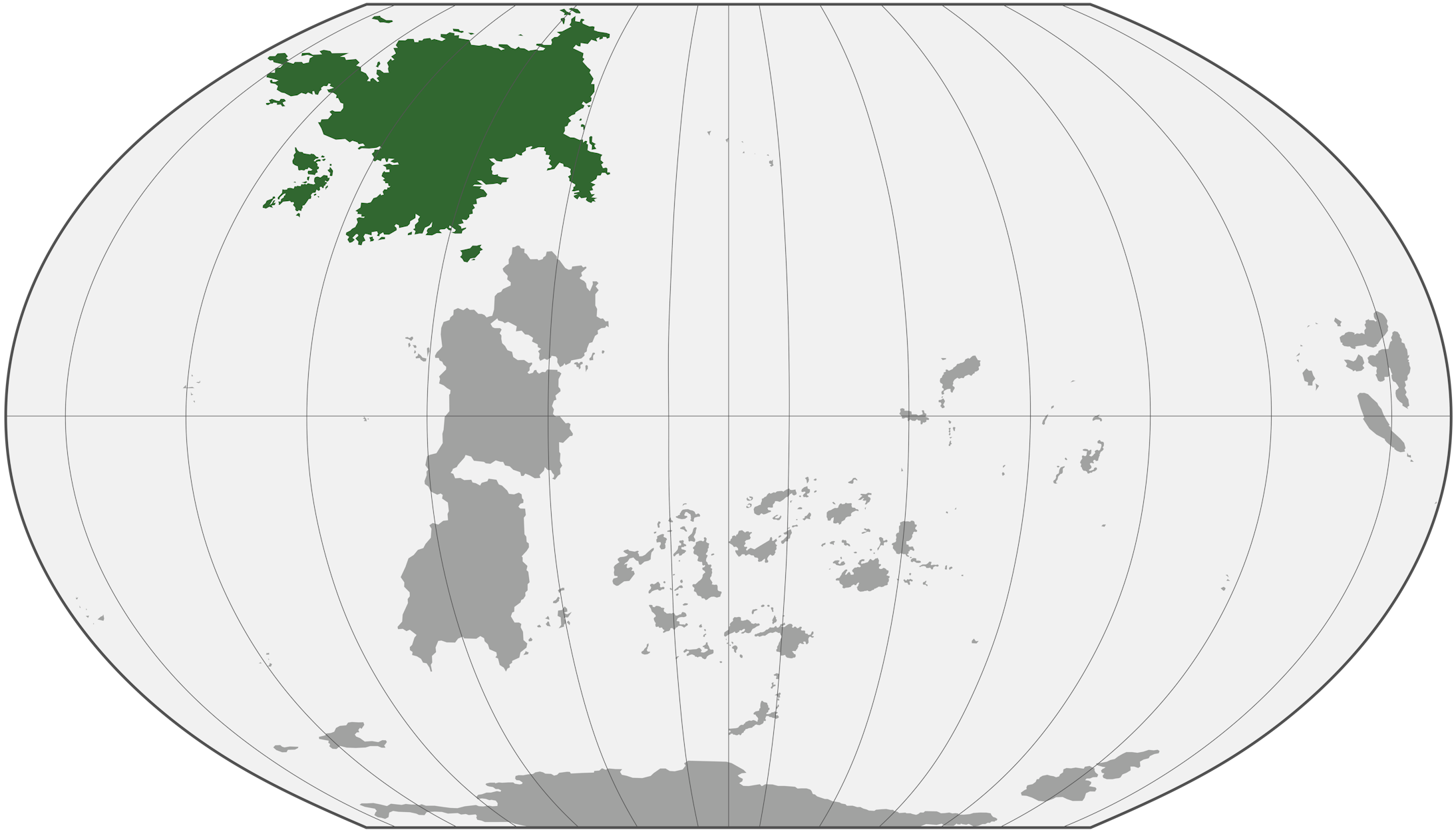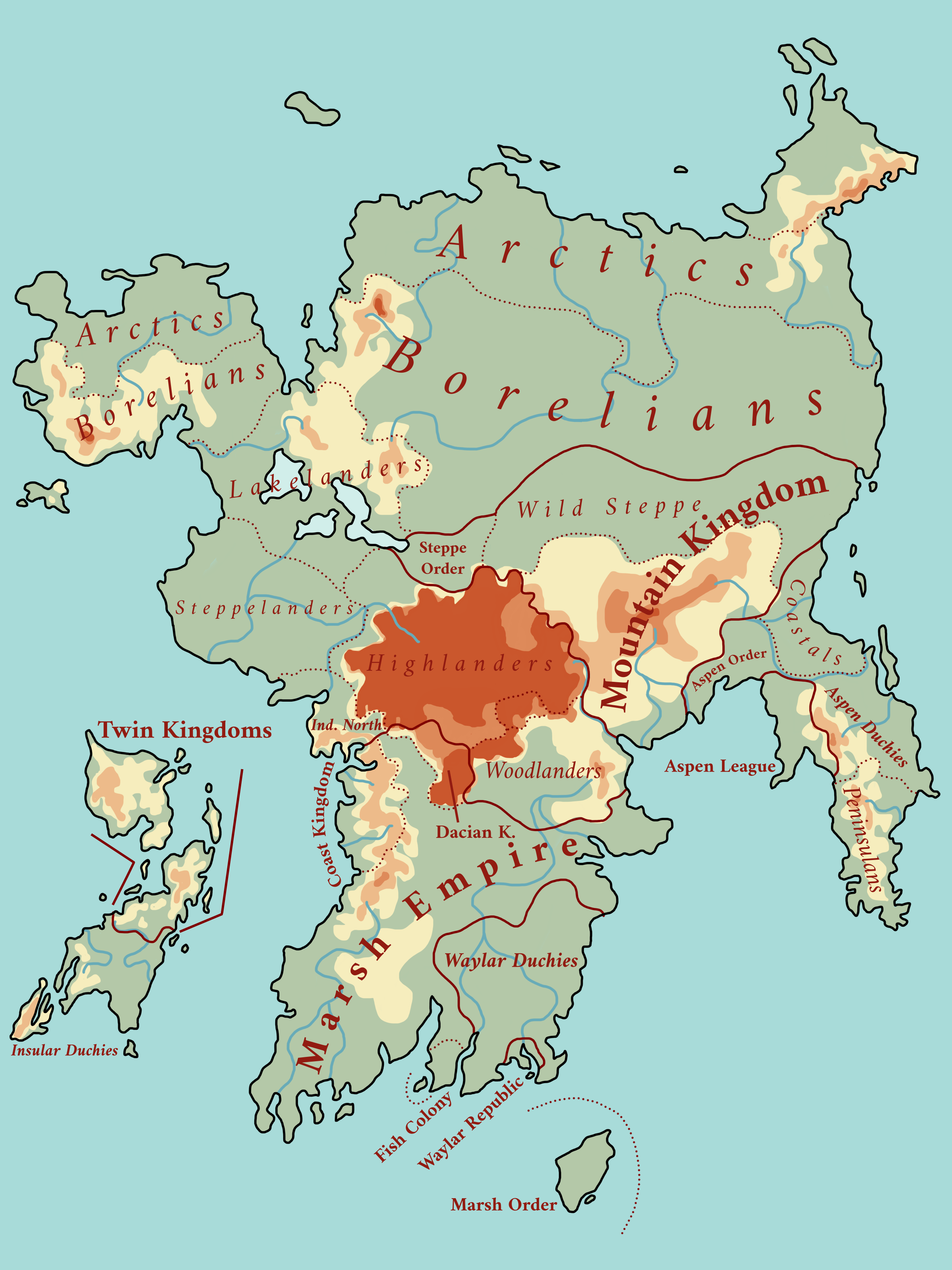The Great Continent is a large landmass located in the northern hemisphere of the planet, extending to the North Pole. The continent is characterized by a diverse range of climates and geographical features. The northern regions are dominated by dense pine forests, ice deserts, and expansive taigas, known for their extreme cold and long winters. In contrast, the southern regions of the continent feature a much warmer climate, with extensive agricultural areas that benefit from fertile soils and temperate conditions. The Great Continent's varied landscapes play a crucial role in shaping the ecology and human activity across its vast expanse.
Climate
The climate of Loša is diverse, encompassing three distinct major biomes. The northern region is predominantly cold to very cold, featuring polar deserts, expansive tundras, and vast taigas, all of which are shaped by harsh, frigid conditions. The central region experiences a more varied climate, ranging from cold to mild, and is characterized by mountainous biomes and extensive steppes, offering a transition between the extreme north and the more temperate south. The southern region is entirely covered by temperate forests, where milder temperatures and more consistent rainfall support lush, dense vegetation. Notably, the southernmost island of Loša is the only area that features a Mediterranean climate, marked by warm, dry summers and mild, wet winters, providing a unique contrast to the rest of the continent's climates.
Terrain
Loša is characterized by a variety of major landscapes, each with distinct ecological and cultural significance. In the far north, the tundra-arctic ecoregion dominates, featuring harsh, frigid conditions. This region is also home to the Great Lakes, a critical geographic feature in the area. Just south of the tundra, expansive coniferous forests serve as the territory of independent beastmen tribes, including the notable Wolf Confederacy, which maintains a unique cultural and social structure.
Further south, the landscape transitions into a vast steppe, historically significant as the birthplace of the Nomadic Empire of Old. This empire, known for its extensive influence and enduring legacy, still has a successor state in existence today, with nomadic human populations continuing to inhabit this region.
Large mountain ranges and the Eastern Highlands serve as natural barriers, dividing the northern regions from the southern and separating the eastern and western parts of the continent. High in these mountains lies an extensive cave system, inhabited by underground-dwelling beastmen, a unique society adapted to life in the subterranean world.
In the southern regions, the landscape features a prominent peninsula with lush aspen forests, which is home to one of the continent's most successful trading confederations. This area is a hub of economic activity, known for its thriving trade networks.
To the southwest, expansive marshlands dominate the landscape, forming a large wetland ecoregion that supports a rich diversity of plant and animal life. Off the western coast, the dual islands are notable for their temperate and montane forests, offering a distinct ecological contrast to the mainland and providing important habitats for various species.
Flora
The flora of Loša is diverse, reflecting the continent's wide range of climates and ecosystems. In the northern tundra-arctic ecoregion, vegetation is sparse and adapted to extreme cold, with hardy species such as dwarf shrubs, mosses, and lichens dominating the landscape. The coniferous forests to the south of the tundra are characterized by vast stands of evergreen trees, including pines, spruces, and firs. These forests provide a crucial habitat for various species and play a significant role in the continent's ecology.
The great steppe, located further south, is home to grassland species that have adapted to the region's semi-arid conditions. Grasses, herbs, and low shrubs dominate this biome, with seasonal wildflowers adding bursts of color during the brief growing season. The steppe's flora is well-suited to the nomadic lifestyle of the human populations that inhabit this area, offering grazing opportunities for livestock.
In the southern region, the aspen forests of the great peninsula are particularly notable for their rich biodiversity. These forests are dominated by aspen trees, which thrive in the temperate climate. The understory of these forests supports a wide variety of plant life, including many species of fungi that play a vital role in the forest ecosystem. The aspen forests are also home to one of the continent's most successful trading confederations, which has historically capitalized on the abundance of natural resources in the area.
The marshlands of the southwestern region support a distinct assemblage of plant species adapted to wetland conditions, including reeds, sedges, and water-loving shrubs. These plants contribute to the rich biodiversity of the wetlands and provide essential habitats for numerous animal species.
On the dual islands off the western coast, temperate and montane forests dominate the landscape. These forests are characterized by a mix of broadleaf and coniferous trees, including oaks, maples, and firs, which support a diverse range of understory plants. The flora of these islands is distinct from the mainland, reflecting the unique environmental conditions and isolation of the islands.
Fauna
The wildlife of the continent is characterized by many prehistoric mammals:
- Aurochs
- Beard bear
- Dragons
- Insular sheep
- Mammoth
- Giant beaver
- Geep
Countries
The two main powers on Loša are the Marsh Empire, a loose elective monarchy, and the Mountain Kingdom, the remnant of a once continent-spanning nomadic empire.
- Marsh Empire
- Coast Kingdom
- Dacian Kingdom
- Fish Colony
- Marsh Order
- Mountain Kingdom
- Steppe Order
- Aspen League
- Aspen Order
- Underground Confederation
- Waylar Republic
- Twin Kingdoms
- Aspen Duchies
- Waylar Duchies
- Insular Duchies
- Woodlander Duchies
- Highlander Duchies
- Coastal Duchies
- Peninsular Duchies
- Independent North

